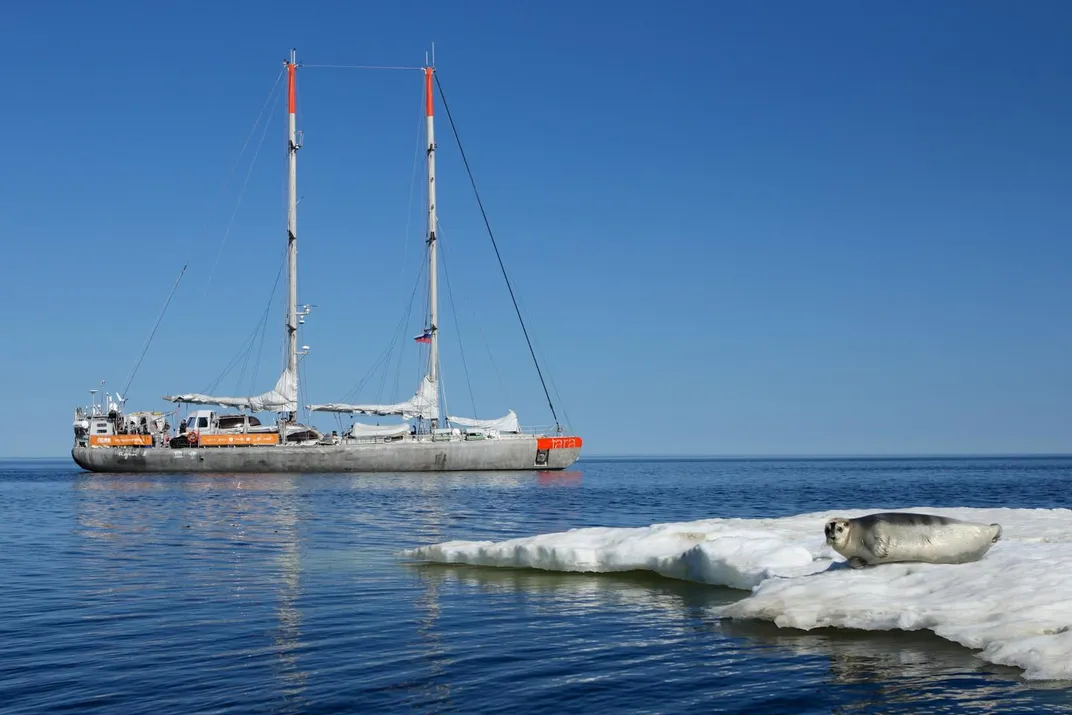Ocean Currents Are Sweeping Billions of Tiny Plastic Bits to the Arctic
Currents are acting like a conveyor belt for plastic, dumping the bits in pristine northern waters
/https://tf-cmsv2-smithsonianmag-media.s3.amazonaws.com/filer/d7/54/d754cbff-df83-401f-9dc8-c793343e84b9/microplastic_and_plankton.jpg)
With so few people, you'd expect the Arctic to be a plastic pollution-free zone, but new research suggests that's far from the truth. Researchers exploring the Arctic Ocean and found that the waters are rife with plastic debris. As Tatiana Schlossberg at The New York Times reports, Arctic waters seem to be a dumping zone for plastic riding along in the ocean's currents.
The plastic was discovered by an international team of researchers who circumnavigated the Arctic on a five-month journey aboard the research vessel Tara in 2013. They sampled the ocean water along the way, looking at plastic pollution. And though the plastic concentrations were overall low, they located a specific region located north of the Greenland and the Barents seas with unusually high concentrations. They published their results in the journal Science Advances.
It seems that the plastic is riding up to the pole with the Thermohaline Circulation, a “conveyor” belt ocean current that transports water from the lower latitudes of the Atlantic Ocean toward the poles. "[A]nd the Greenland and the Barents Seas act as a dead-end for this poleward conveyor belt,”Andrés Cózar Cabañas, lead author of the study and researcher at the University of Cadiz, Spain, says in a press release.
The researchers estimate that the amount of plastic in that area is in the hundreds of tons, made up of hundreds of thousands of the tiny pieces per square kilometer. And the scale may be even larger, according to the researchers, due to plastic that may have accumulated on the floor of the ocean in the region.
“Even though the vast majority of the Arctic is fine, there’s this bullseye, there’s this hotspot of very, very polluted waters,” Erik van Sebille, co-author of the study, tells Rachel Becker at The Verge.
While there is a remote possibility that plastic is being dumped directly into the Barents Sea, the icy stretch of water between Scandinavia and Russia, the condition of the plastic found suggests that it has been in the ocean awhile.
“The plastic pieces that may have been initially inches or feet in size, they have been brittled by exposure to the sun and then fragmented into increasingly smaller particles, and eventually led to this millimeter-size plastic that we call microplastic,” Carlos Duarte, co-author of the study, tells Chris Mooney at The Washington Post. “That process takes years to decades. So the type of material that we’re seeing there has indications that it has entered the ocean decades ago.”

As Schlossberg reports, eight million tons of plastic make their way into the ocean each year, with around 110 million tons accumulating in global waters so far. While the plastic waste in Arctic waters only accounts for less than tree percent of that total, Duarte tells Mooney that the accumulations in the Arctic are just the beginning. There is likely decades of plastic from the eastern U.S. and Europe still in transit that will eventually make it to the Arctic.
Researchers have identified several subtropical gyres in the world’s oceans where microplastics tend to accumulate. The worry now is that the Arctic will join the list. “This region is an impasse, a dead end where marine currents deposit debris on the surface,” study co-author Maria-Luiza Pedrotti says in the press release. “We may be witnessing the formation of another garbage dump on the planet, without fully understanding the risks to local fauna and flora.”
While there are some pie-in-the sky ideas being worked on to clean up plastic debris in the ocean, most notably the Ocean Cleanup Project, the researchers conclude in the press release that the best solution is to work harder to keep plastic from reaching the ocean in the first place.